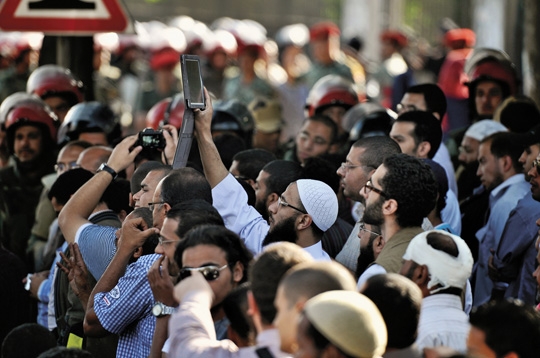
Jonathan Rashad, from the Flickr album Egypt Clashes, May 2012
«Cairo. Open City. New Testimonies From An Ongoing Revolution»
Deutschsprachige Version dieses Beitrags hier.
«Egyptian artists, photographers, activists and curators were involved in planning the exhibition, which features shots by foreign and Egyptian news agency photographers – the classical protagonists of journalistic coverage – but also a Twitter wall, video portraits of eyewitnesses, video recordings and photos made by activists and ‘civilian journalists’ published on media portals such as Flickr, and documents collected by artists, having been created as means of expressing opinions, influencing the course of events, preserving memories, commemorating victims and bearing testimony. On the one hand, the exhibition sheds light on the omnipresence of digital observation, the livestream of the revolution, and the new forms of dissemination and alternative news reporting by way of communication platforms and social media such as Facebook and Twitter. Yet the show is also concerned with the circulation of these images, their presence in the urban realm, the role they play on banners, magazine covers, graffiti, etc.», as an advertising text for the exhibition states.
ZFM spoke with Florian Ebner, one of the two curators of the exhibition and the Head of Department of Photography at Museum Folkwang, Essen; He is also the curator of the German Pavilion at the Venice Biennal 2015.1
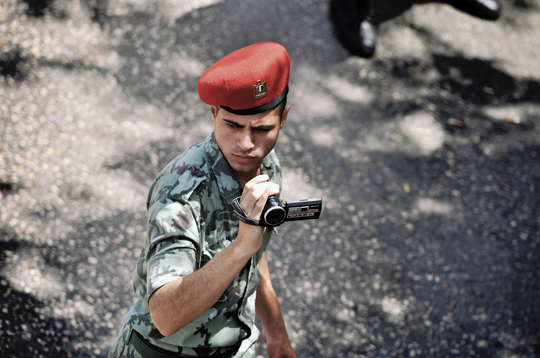
Jonathan Rashad, Protest march to the Ministry of Defence and sit-in, 04/28/12
Kathrin Peters: To begin with, could you maybe tell us how you approached the research. How did you deal with the «naive empathy» – also described in the catalogue – a phrase that vividly grasps the enthusiasm for these ‹other›, and in a particular way networked images, and at the same time asks: How can one find a way to approach this vast array of images?
Florian Ebner We directly approached curators in Cairo; Edgar Blume, a young arabist at the Goethe Institute, and Günther Hasenkamp, their head of cultural programmes, both helped us to make contacts. Thanks to Egyptian-German blogger Philip Rizk, we were fortunately able to very quickly establish contacts with the revolutionary scene. The further development of the exhibition evolved out of these relations. I went to Cairo six times, co-curator Constanze Wicke even lived there for two months, maintaining and extending our contacts. We initiated and managed the project, but the different sections of the exhibition were all curated by Egyptians. We had the role of editors.
Ulrike Bergermann: Were you confronted with scepticism?
F.E. In the beginning there were huge reservations, also from the curators of the Townhouse Gallery, who had to deal with the fact that at that time the whole world wanted to get in touch with the new hotspots of the Arab art scene. But we always tried to emphasize our understanding. Of course, it is not our history but we were very impressed by the events and the images being produced of it. The exhibition should be understood as an opportunity to tell two stories, that of the actors on the one hand and that of the pictures on the other. And these two stories should emerge in collaboration.
K.P. What was and is your key interest in the pictures – what do you mean by the phrase «new pictures»?
F.E. First of all, the issue of the new digital channels, the new sites of the pictures: Facebook, Twitter, Flickr. Already on our first visit, we were worried that we would identify with that part of the revolution closest to us – the internet generation of young Egyptians, often with one western parent – who only form a small group within the revolution. This concern stayed with us for quite some time. The «new pictures» are on the one hand always the newest, latest pictures, but on the other also «novel» pictures. It is important to understand that we cannot separate this new digital world from the old – especially in Egypt. They both belong together, the power of the street and the power of the internet, the pictures move into the city and also back out of it.
K.P. So, the «new» refers to the materiality of the pictures as well as the possibility of their circulation?
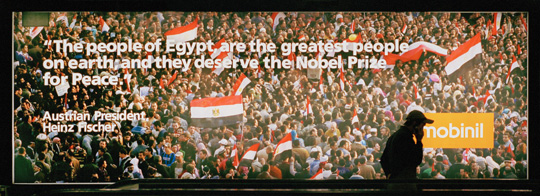
Illuminated billboard by Mobilnil at Cairo International Airport, December 2011
F.E. That was the key question: What role do the pictures play in the revolution, who gets to see which pictures? When you arrive at Cairo airport, you are greeted by a huge illuminated billboard advertising a mobile network operator, which shows the surging masses at Tahrir square. There is an enourmous range of different uses of these pictures. When we talked about our work, young people would take out their mobile phones and show us pictures, which they, if they had internet access, would then publish on Facebook and Twitter. From the beginning, the photographs were part of a participatory, communicative context. We wanted to stress this aspect in the exhibition, but we also tried to show the whole range of images, from Magnum photographer to those moments when the importance of these mobile recording devices for the people in the streets become apparent. Back then, the artists’ initiative «ThawraMedia» or «revolutionary media», started to engage with the people who took pictures alongside the professional photographers. They collected this data, which is now made accessible as an internet archive.2
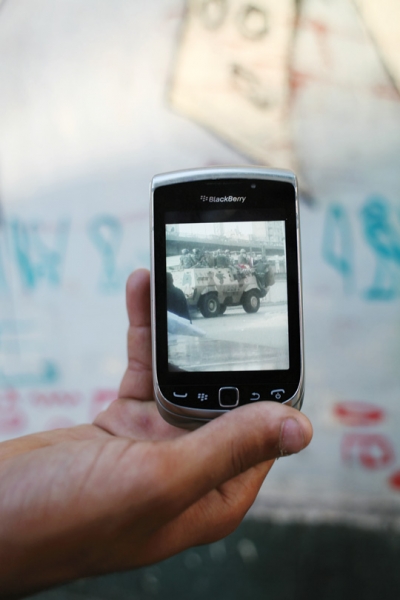
Myriam Abdelaziz, from the series Cell Phone Stories, 2012
K.P. How exactly does ThawraMedia work?
The three protagonists, a photographer, a blogger and a film maker, decided to put up a tent with a sign that read: «Bring us your images». The pictures were saved on laptops and hard drives and show a certain ‹mobile aesthetics›, fuzziness, blurs and shakes, etc. In order to protect the photographers their personal data was anonymized. On special days, like for instance January 25, 2011, the day the first mass rallies took place, very clear peaks in image numbers can be observed. This poses the question: How many pictures remain of January 25 in the end? There are the press photographs and some others, but many vanish. The idea was to create a kind of national counter-archive.
K.P. There was also another initiative, Mosireen, which organized workshops in rural areas.
Exactly. The topic was «revolutionary film making», a kind of new genre of documentary video, for which they coined the term «video testimony». Having the length of a clip, four to five minutes, people – talking heads – talk about what they saw, and cut in are, for instance, shots from official television footage. The point is that the reports of violent events are not just rumors spread by some agents provocateurs, but instead people like you and I have witnessed them. For example, take the case of Toussi, a young man who was found dead in the street and his body was thrown in the garbage by soldiers. Quite a few Egyptians reported that they had observed this and were so outraged that they decided to take back the street. Jasmina Metwaly is a member of the Mosireen collective who followed this story, and visited the parents and friends of Toussi. In the simple recordings she produced the mother, the girlfriend and other people talk about the event, and shots from the mortuary are cut in between them. Mosireen also runs a YouTube-Kanal. According to the collective, in December 2011 the channel was one of the most frequently watched non-profit channels in the Arab world – so it was really influential.
U.B. How exactly did your editing process work, from the selection of pictures to the spatial production?
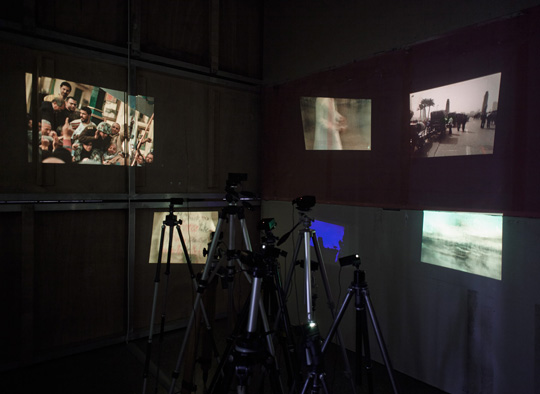
ThawraMedia, exhibition view Museum Folkwang, Essen 2013. Photo: Manuel Reinartz
The question was how to bring pictures to a German art venue that are already circulating and emerged in a context in which they had a practical political function. What does it mean? What is lost and what is gained in the process? During our research we met many artists whose pictures were getting sold to big galleries in London, but we wanted to present the pictures in a materiality which was closer to their original emergence, in order to address the different «aggregation states» of the images on the level of the medium. In practical terms, we decided to use small LCD projectors to present often rather volatile mobile phone pictures and amateur pictures which can be accessed online on ThawraMedia, but which no one finds anymore. The images were selected by the artists themselves. As many artists couldn’t be present for the installation of the works here in Germany, we tried to decide on the format beforehand, in mutual trust. In turn, artist Heba Farid knew from the beginning how she wanted her selection.
K.P. What about the blogs that are presented in the show?
Concerning the blogs our input was much stronger than in other parts of the exhibition. We found pictures by Jonathan Rashad on Flickr, where one event is documented by 40 images. In comparison to one photo that is selected by an editorial office, this captures the event in a completely different way. Another Flickr album called «Masks of Tahrir» contains a lot of extremely interesting pictures and we suggested presenting the multiplicity of pictures as a large wallpaper. Initially, Mosa’ab Elshamy, the photographer of the series, had thought of large-format prints in frames, but the resolution of the Flickr pictures wouldn’t have been sufficient for this, and eventually he agreed to our idea.
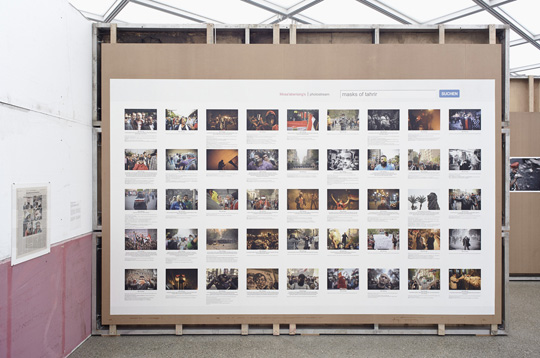
Mosa’ab Elshamy, «Masks of Tahrir», exhibition view, Museum Folkwang, Essen, 2013, Photo: Manuel Reinartz
K.P. On the Flickr accounts of Jonathan Rashad or Mosa’ab Elshamy, there are very different kinds of «favorites» – photographs of actresses, landscapes ... Here, the pictures of the revolution are embedded in completely different contexts. Apparently, the revolution doesn’t take place every day and the photographers also have other aesthetic interests.
We had planned a category in which Mosa’ab Elshamy presented his favorite pictures – but unfortunately, it didn’t make it into the catalogue, partly because those pictures were totally different from the ones we selected. He chose motifs that were much more heroic, impressive. Off course, they were really young at that time, in 2011 they were only 20, 21 years old. Jonathen Rashad was still in college then, today he is much more professional. It was fascinating to me to see people just using their cameras to approach the events, and the outcome is all this material. For a curator it is somewhat like constantly looking at contact sheets. They convey the impression of a certain casualness inherent to the production process of these pictures, as well as a certain richness that distinguishes them from the classic journalistic testimony because they are less overdetermined. Journalism tries to put everything in one picture, it regulates what can be distributed. Here, on the contrary, in this simultaneity some kind of a Barthesian «reality effect» emerges, it’s unfiltered.
U.B. Traditionally, in order to achieve the character of a testimony a photorealistic impression would be linked with the effect of authenticity of classical analogue photography. This can also be seen in digital photography’s blurry aesthetics. Actually, what ‹authorizes› these images, makes them witnesses, is actually less connected to «Barthes» and the classical criteria than to the internal referential character of the images, their circulation between platforms, from mobile phones to videos, from TV screen to photographs, many of them on posters and as graffiti... In the exhibition these routes are very precisely documented, the names of the files and websites have a date, etc., and as a result they mutually validate each other. The effect of plausibility is strongly linked to the images’ specific context, their circulation between media platforms, their traceble routes and the known authorship or perspective of the images. If one thinks of them with Latour as «cascades of inscriptions», which supersede the «decisive moment» of a Magnum photographer or a singular Barthesian «punctum», then how can this be approached for an exhibition. How can something like that be produced, especially by an editor, in relation with curators?
The curators fixed the sections, made their suggestions, and then we as editors were the ones checking if motifs were repeated or reappeared later, i.e. as graffiti, inscriptions, stickers, or on banners. We selected these images and suggested presenting them. It was essentially our task to make their chains visible, to show how pictures circulate, not only depicting events but also provoking new events.
One video shows this in a nutshell. Mohammed, a young street vendor, explains why he decided to take to the street. It was because he had seen footage of various scenes, for instance footage of a dead protester, but also footage of other attacks such as the famous «Woman in the Blue Bra», where a young woman was severly beaten by the police and left injured and exposed in the street. While the video The Politics of Bread shows these scenes it also tells another story of web-images: a young man, Mohammad Mounir, was arrested and during interrogation he was beaten unconscious. A policeman filming with his mobile phone showed how during interrogation money was taken from his pocket. He uploaded the recording in order to denounce the young man as a paid agent of the state. In this single video, Philip Rizk brings together the different valences and qualities of the internet.
In these documents such chains of pictures, pictures that initiate actions, become very visible. Again and again the ‘Woman in the Blue Bra’ reappears as graffiti, or in protest marches in which people carry her image – it is the most pervasive motif. The exhibition, as well as the catalogue, are both constituted by such comparative juxtapositions.
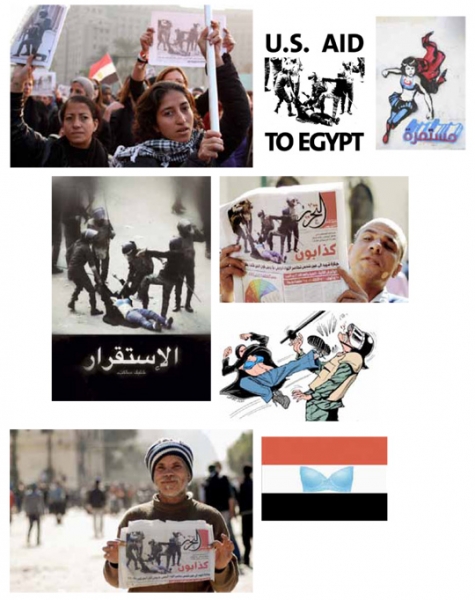
«Woman in the Blue Bra», documents compiled by Rowan El Shimi (by making use of images by Aly Hazza’a, El Teneen, montage with screenshot of CNN-report, Carlos Latuff, Rowan El Shimi).
K.P. And as a result digital and analog, online and offline presentations are interwoven – a picture becomes a graffiti in the city space, which again is photographed and uploaded on the internet or published in newspapers.
A similar example is the «Street of Martyrs», Mohamed-Mahmoud-Street. In November 2011, many protesters died in this street, which then reappears at many other sites in graffiti. At the same time, for many young Egyptians the street is a preferred location to pose for pictures that they then upload on the internet. By carefully looking at the book it becomes apparant that this interlocking of the street, internet, digital image culture and Facebook pages is of great importance. For us, it was difficult to get access to the Egyptian Facebook culture because we couldn’t read the Arabic sites, but here we also had a contact person, Lilian Wagdy. There is one chapter in the book about one of her actions: after January 28, 2011, one of the most bloody days of the rebellion, she started an appeal on her Facebook page and asked people to send her pictures taken that day. The reason was that in Egypt the public attention was almost entirely focused on Cairo, meaning the events in other cities in the Nile Delta like Tantra, Alexandria, Port Said, in which people had also died, weren’t covered. In the collection that resulted from her call the various aesthetics we have already mentioned reappear, from blurry pictures taken with mobile phones to press photographs taken with a good camera.
U.B. Is the classical form of testimony that was based on a relatively direct indexicality of the photographic replaced by the interlocking of platforms? If so then there are no longer authors of the images but a vague authorship – can we identify this authorship with the curator or with a concept?
The longer we worked on this exhibition, the clearer it became that we can no longer think in binary categories. We tried to define our method instead as a juxtaposition, and if possible we wanted to present the images together with the voices that belonged to them: «plurality of voices» was one category in the exhibition. On the one hand there are the Flickr albums, the reactions to them, the comments, the eyewitness videos on internet platforms. But on the other, there is also something like the auteur, such as the Cairo based French photographer Denis Deilleux, who went to the different districts to photograph the relatives of the deceased. This is clearly the position of a photographer who is working with an analog medium-format camera with a book project in mind. Hence, there is this juxtaposition of various qualities of testimonies. We approached this exhibition more as photography historians than as media scholars thinking about intermediality and the internet. For us, it was more important to show the images themselves and their juxtaposition.
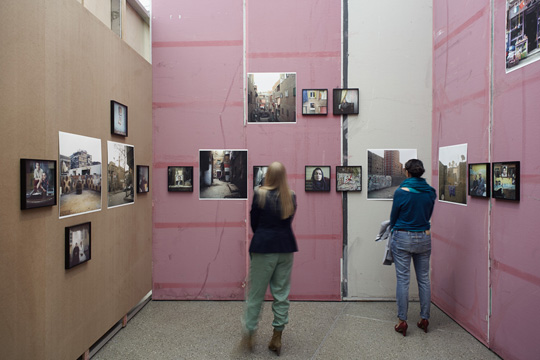
Denis Deilleux, Memories of a Revolution, 2012, Exhibition view Museum Folkwang, 2013. Photo: Manuel Reinartz
K.P. The difference you described between the pictures by professional or amateur photographers becomes apparent in the exhibition. But at the same time the pictures are all journalistic – they could have been made at another occasion in a similar way – because they are crucial for the local distribution of information.
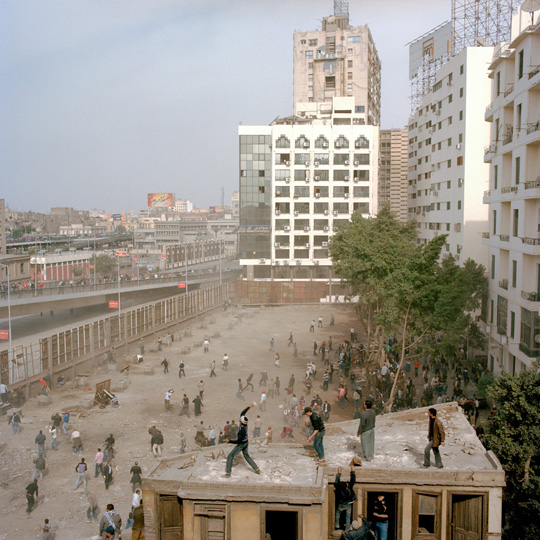
Ivor Prickett, from the series Days of Anger, 2011, Copyright: Ivor Prickett
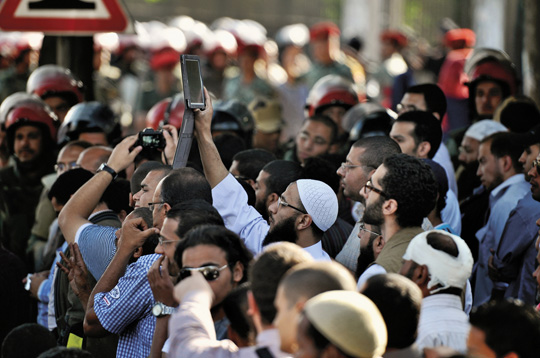
Jonathan Rashad, from the Flickr album Egypt Clashes, May 2012
F.E. That is exactly what we tried to show. Everything these pictures communicate locally concerns one specific day, and is produced by for instance as many as eighteen photographers all working for the independent newspaper El Shorouk. Here in our media this practice no longer exists. In addition, for the Egyptian producers of these pictures it is a question of attitude, of commitment, and of claiming: There is no separation; I am part of the movement.
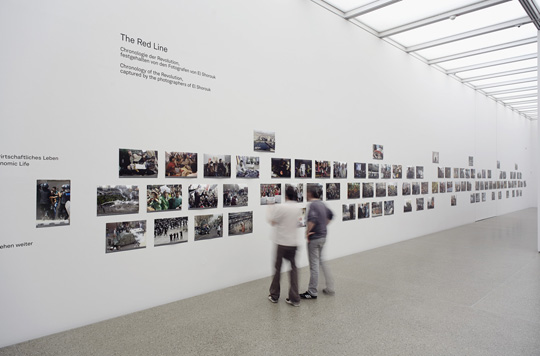
Images by the photo agency El Shorouk, exhibition view Museum Folkwang, Essen 2013. Photo: Manuel Reinartz
K.P. Could we then describe it as a different notion of journalism, one that doesn’t rely on the creative logic of the «decisive moment» or of the World Press Photo Award, but that defines the images through their framing, their circulation – even the printed ones?
F.E. The producers of pictures here are definitely young people who are not professionally trained (photo-)journalists, but nevertheless their role models are great photographers. Accordingly, we showed the whole thing – clipped to the wall with magnets instead of with passe-partous in frames. Those images aren’t suitable as large print history pictures in the traditional photographic sense. But they nevertheless try the same thing as classical press photographers; to compact the events and to communicate them in one picture. Even though not every photo is technically compelling, the pictures do possess their own quality and are oftentimes more affecting and fascinating than the pictures taken by western photojournalists who subordinate everything to their aesthetic concept.
U.B. Did the representation of violence pose a problem? Some areas in the exhibit could only be entered by those over 18, and videostills outside of the video cubicles explained the content of what was shown inside. Did you debate this question with the Museums?
F.E. Generally, the representation of violence followed the particular policy of the specific museum. At Museum Folkwang the museum and their PR representatives talked to the Essen authorities regarding the terms of display. As I learned afterwards, state security even came and inspected the exhibition looking for politically problematic representations, such as images of the Muslim Brotherhood. It seems there was a great fear that things could have gotten too political, and out of control. Although in this context, one cannot do without images of dead people.
U.B. One prominent element of the installation are the images that are neither framed nor projected on a wall, but put on banners leaning against the walls as if they could be picked up at any moment and carried to the next protest march. Each of these shows pictures of images, protesters who carry images themselves, etc. How should we understand this; as a quotation, as encouragement to participation, or as a reminder of the street?
Rowan El Shimi, a young freelance journalist working mainly in the online section of one of the major newspapers curated this part. The idea was to develop together with her a kind of iconography – stereotypes and icons – of the images. For example, she researched the section on the ‘Woman in the Blue Bra’ for the exhibition, as well as the variety of signs and images that appeared at Tahrir square, where people communicated not only verbally but also through the famous image of the shoes, or the images of the martyrs. The concept of the banners is that these pictures are precisely not outstanding photographs, but images that play a specific role in the protests. We wanted to stress the public character of these images.
K.P. The exhibition tries to slightly break the western obsession with the so called “Arab Spring”, and to add archival images that put the rather romantic idea of a suddenly erupting event in context.
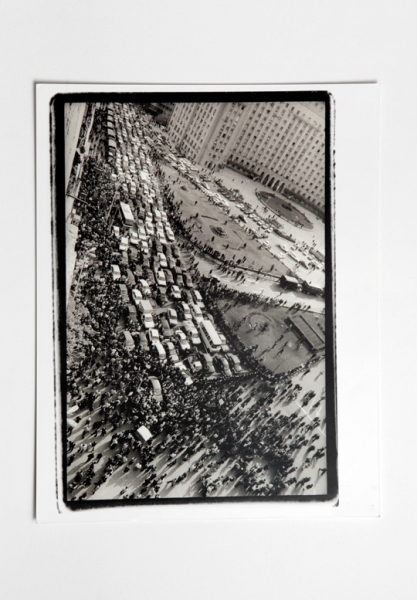
Randa Shaat, from the series Under the Same Sky, Cairo 2003, Copyright Randa Shaat
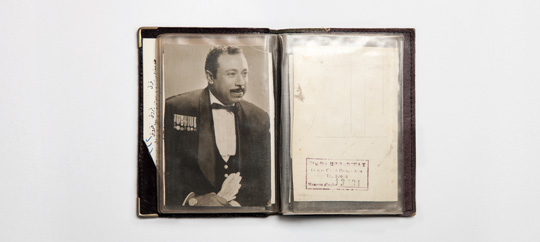
Heba Farid, «General» Louis Ibrahim Album, from the series Making Heroes – Photograph Albums from Egyptian Military and Police Officers, Collection Amgad Naguib
Especially when the exhibition was presented in Essen and Hamburg we tried to clearly highlight this pre-history, and the work of Heba Farid shows two aspects of this. One follows our request to present earlier Egyptian photojournalism – which was performed only by a few people who were confronted with censorship – and thus very different from the situation at the time of the Arab Spring. The other was the historical prevalence of photo albums focussing on the identity of the military. In the young, modern Egypt of the 1950s under president Nasser, but even still under Sadat, the military was seen in an extremely positive light. Only in the last years under Mubarak’s reign did people realise that they had distributed the wealth amongst themselves. These photo albums were supposed to show the importance of the military for the pride of the country. And, of course, they also represent an aspect of the «old» media that has now been replaced by Facebook.
K.P. In the exhibition different approaches can be distinguished: the activist stance of groups like Mosireen, ThawraMedia or Tahrir Cinema, an initiative that projected Facebook pages at Tahrir square for those who didn’t have access to the internet when, as happened on January 28, there was a shut down of all telecommunications …
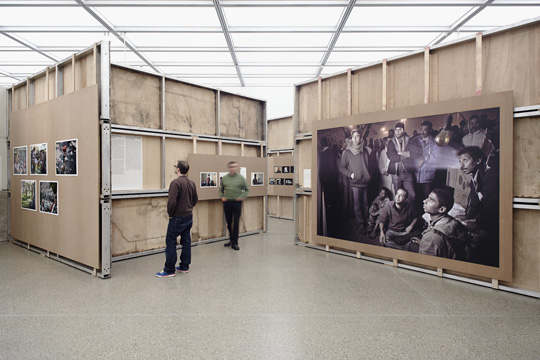
Public projection of Facebook pages, exhibition view, Museum Folkwang, Essen 2013. Photo: Manuel Reinartz
… which actually had completely the opposite effect to that intended, and because of the shutdown people took to the street more than ever. It is also interesting to see who took part in the shut down. Basically all mobile network carriers took part, but many, such as Mobinil, later used pictures of the square as the icon of the revolution for advertising…
K.P. … a second stance is formed by the various forms of documentarism that are all very invested in a politics of truth. This is represented by, for example, the Flickr users as much as the documentary or archival practices like Heba Farid’s, who is also the coordinator of the Photographic Memory of Egypt programme. A third stance is taken by the distinctly artistic projects. How did you want to combine the journalistic and the artistic forms?
Actually, that was the most difficult task. How can those two be brought together? We had an interesting e-mail discussion with the artist Hassan Khan, in which it was clear that this issue is already subject to a heated debate in the Egyptian art scene, and that there is no agreement on the question of whether it is or isn’t okay to work on the revolution. There is one party that is, for various reasons, rather reserved. These are people who don’t want to form an attitude towards the revolution yet, because first they want to see what is happening next, or who consider it naive to believe that they are actually recognized for their artistic work and not only for the «hipness» of the topic. Then there are some people who are dashing ahead, and who think it is the first time that one can actually take charge of one’s own fate, that one cannot miss this chance and that anything else would be snobbish. We wanted to invite artists like Hassan Khan, who is by the way also an excellent writer, but he didn’t want to participate in the exhibition. His sister Nadine Khan however, did participate, but at the same time her video I Will Speak of the Revolution is a deliberate rejection of representation. Filming her feet while walking to Tahrir square she explains why it is not the time to work artistically on the revolution. She says: «The power of Tahrir is that it cannot be owned or framed.» We felt it was important to present this piece in the exhibition because of its strong statement on the dilemma of representation. It was always our wish to present artistic works that address other revolutions, or the time before the revolution, or the question of surveillance, the question of media, etc ...
Nadine Khan, Mariam Mekiwi, I Will Speak of the Revolution, 2011 (HD-Video, 1:07')
A broad field ... Some of the artists say: I engage with the revolution, not as an artist but as a human being, because I care for our society. Others say: I am tired of being asked by the West about revolutionary art because I meet their clichéd expectations. But there is also graffiti, street paintings – which we included but only in the form of pictures, precisely because we considered some attitudes that are well received in the art market to be difficult or naive. So we took sides with a kind of «citizen journalism», even though the material is challenging and doesn’t directly follow (or match) our conceptions of art.
U.B. At the beginning of 2014 an updated insert was added to the catalogue that addresses the polarisation between Mursi followers and opponents, which a year earlier hadn’t emerged yet. Did you have to think about political balance?
This is an important question. It was clear that the exhibition presents a specific position and that it is sympathetic to the notion of a civil society that is closer to our own. In a discussion with one filmmaker we agreed that he would compile material that in part was produced by Muslim Brothers. But for time reasons the collaboration didn’t work out. It wasn’t realistic that we could cover the whole spectrum of positions by ourselves, and we had to also include testimonies that took a completely different perspective to our own. Various voices were excluded unless there were photographs of rallies of the respective parties, for example a direct voice of the Muslim Brotherhood isn’t represented in the exhibition.
U.B. Now, three years after the revolution, the main issue addressed in the media is the disappointment about all the things that weren’t achieved, and the political costs of the initial joy of the revolutionary awakening.
Our concept for the presentation of the exhibition in Cairo – which still needs to be discussed with the people there – would be to start with the newspaper wall that was received with great enthusiasm by many Egyptian visitors in Essen. But there is the wider question of whether the exhibition project should be presented in Cairo. We are thinking of confronting a selection of individual works with more recent journalistic images that show how the meaning of the images has shifted within the last two or three years.
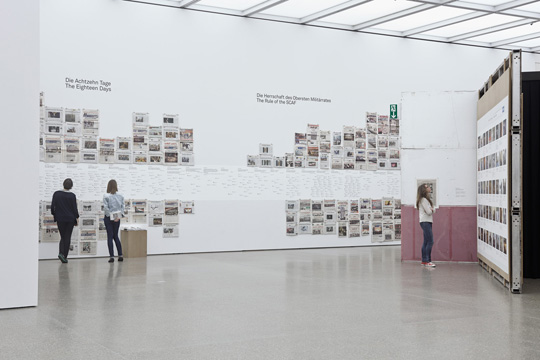
Wall with a chronology of newspapers and tweets, exhibition view, Museum Folkwang, Essen 2012. Photo: Manuel Reinartz
This conversation was also published in German in: Zeitschrift für Medienwissenschaft, 10, 1/2014, 97–109.
Translated by Maja Figge.
- 1The exhibition was first shown at the Museum of Photography Braunschweig/ 267 Quarters for contemporary Art and The Photography of Braunschweig University of Art (HBK) (Sept-Dec 2012). After that, in each case an updated edition was presented at Museum Folkwang, Essen and at Museum für Kunst und Gewerbe Hamburg (August-November 2013).
The catalogue documents the graphic material and the discussions held about the concept of the exhibition: Cairo. Open City. New Testimonies from an Ongoing Revolution, edited by Florian Ebner and Constanze Wicke, Leipzig (Spector Books) 2013 (trilingual). It includes among others: Ebner, Wicke, «Intervening Images: Towards a mapping of a revolution in pictures», 39-45; Philip Risk, «2011 is not 1968: Open Letter to an onlooker», 53-59.
Exhibition concept: Florian Ebner and Constanze Wicke in collaboration with Lara Baladi, Osama Dawod, Rowan El Shimi, Heba Farid, Thomas Hartwell, Tarek Hefny, Ahmed Kamel, Jasmina Metwaly, Alex Nunns, Philip Rizk. Supported by the German Federal Cultural Foundation and Goethe-Institut Cairo.
We thank Esther Ruelfs, Constanze Wicke and Florian Ebner as well as Museum für Kunst und Gewerbe Hamburg and Museum Folkwang, Essen.
- 2Editor's note: The website is no longer available.
Bevorzugte Zitationsweise
Die Open-Access-Veröffentlichung erfolgt unter der Creative Commons-Lizenz CC BY-SA 4.0 DE.